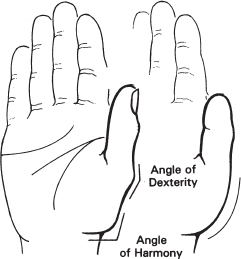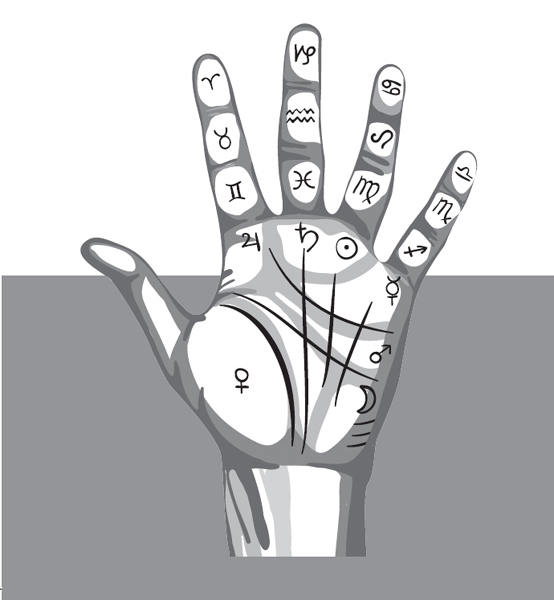
So now, let us consider a few details. The first thing to grasp is that the areas of the hand each apply to a different area of life. Looking at a hand is rather like reading the kind of map that surveys the landscape and shows the features of its terrain. Each part of the hand is associated with a particular attribute or interest in the subject's life.
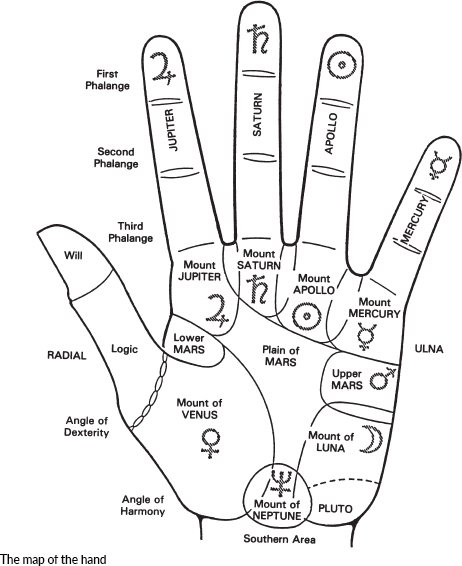
The Indo-European palmistry that we use has links to the planets in astrology, but there are subtle differences between a palmist's views of the planetary connections and that of astrologers. As an astrologer and a palmist, I feel that the palmist's view of the planetary meanings harks back to the early days of astrology. Modern western astrology has drifted away somewhat from these basics. Here is a brief introduction to the way we view the planets and their associated areas of the hand.
| Apollo (the Sun) | Artistry, creativity, the family, leisure activities. |
| Luna (the Moon) | The imagination, travel and restlessness. Creativity, the unconscious mind. |
| Mercury | Communication, work, elementary education, interests, literacy and numeracy, dexterity, health, sexuality. |
| Venus | Luxury, possessions, ownership, love of beauty, passion, friendship, love, affection. |
| Mars | Aggression and assertiveness, courage, enthusiasm, energy, military matters. |
| Jupiter | Belief, leadership qualities, ego, teaching ability. |
| Saturn | Science, study, practical matters, hard work, structure, financial security, old age. |
| Uranus | Not yet used in palmistry. |
| Neptune | Imagination, psychic perception, the bridge between the conscious and unconscious, and a bridge between the spiritual and the practical world. |
| Pluto | Travel, escapism, restlessness, boredom with ordinary life. (I suspect that this has just been tacked on by palmists for convenience sake. This mount sounds much more like a combination of Uranus and Neptune to me.) |
Palmists call the areas on the palm of a hand mounts, despite the fact that some look more like valleys. In this chapter and elsewhere in this book, I occasionally refer to mounts being larger, smaller, higher, lower, narrower or wider than normal. I am aware that this is hard for a beginner to judge, so I suggest that you line up a half-dozen of your friends and see how their hands vary. You will see that most of the mounts are similar on most of their hands, but one person among them will have a mount that is higher and larger than the others and vice versa. This will give you some idea of the differences that you can see in a bunch of hands.
This mount lies directly below the Jupiter finger. It relates to the ego, self-belief and the chances of success. It also concerns honesty, wisdom and idealism. It is good to have a moderate mount of Jupiter, but a high one suggests that the person is so self-centered that he cannot see the needs of others. A high mount signifies an over-inflated ego while a flat one shows a lack of confidence but also a capacity for hard work. If a cross appears on this mount, it signifies marriage to someone who has money.
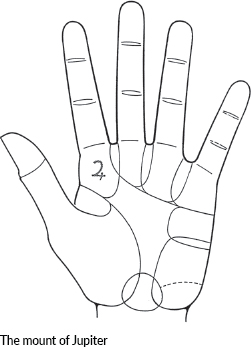
The Saturn area rarely forms a mount. If there is a fleshy area between the Saturn and Apollo fingers, the individual has a certain sense of style and the ability to work hard at something creative. If this area is shallow—that is if there is very little space between the base of the fingers and the heart line—the subject may be materialistic and unable to show affection or give love. The area is mainly concerned with practical matters such as security, keeping a roof over one's head, money, resources and to some extent, career and business matters. Lines that run vertically up this mount demonstrate a desire for security and perhaps concerns about finances later in life.
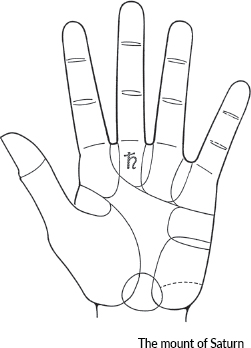
This is often more like a valley than a mount. If the area is cramped, the subject may be a sourpuss who can't enjoy himself or give pleasure to others. The area is concerned with home life, family matters, the arts, music, happiness, and creativity. Vertical lines in this area ensure happiness in later life.
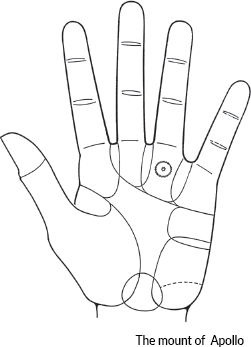
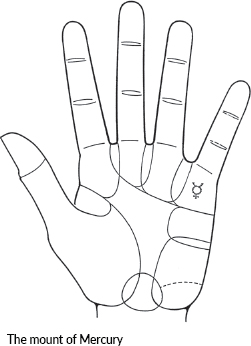
If the Mercury mount is substantial and full, the person will be intelligent and he will have a talent for communication and for listening to others. He may work with machinery or he may teach. A cross here shows technical ability such as working with computers and other office equipment. It can also relate to playing an instrument or being a clever engineer.
This area is also concerned with health and healing, so marks here indicate a talent for healing. There may be three diagonal lines running vertically up this mount, signifying an ability to give healing, either though conventional medicine or as a spiritual healer.
The mount of Venus relates to desire, passion and the “feel-good” factor. Tradition tells us that a person with a large and prominent mount of Venus is sexy, but he is certainly passionate. He may be passionate about collecting art, music, the theatre, his home and family, gourmet food, travel, keeping horses or something else entirely. The passion is less likely to be for a cause, political or spiritual belief and more likely to be for something personal.
If this mount is full and high, the subject craves beauty, possessions and luxury and he may be possessive. A well-developed Venus endows an individual with energy and determination and is often an indicator of potential or actual worldly success. If this mount is too large or too high, it shows self-indulgence, greed, laziness, selfishness, too much sexuality and a jealous or bullying nature. If this person has the right combination of characteristics, he will be highly successful, as the desire to have what he wants will spur him on. However, laziness and a love of luxury may be his downfall.
A flat mount of Venus still endows energy as long as the area is large. This subject is big-hearted and generous. Large Venus mounts, whether high or low, usually tell us that this person will make money—mainly because he cannot stand the thought of having to budget or do without the things he likes, but also because he doesn't wish to depend upon others.
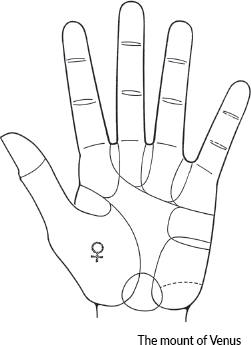
If the mount is cramped, the subject may be happy to get along with few possessions in favor of the freedom to be himself. He may be miserly and remote with a preference for a lonely, Spartan lifestyle. He may still be sociable and even sexual, but he is not keen to live with others or to clutter up his life with many possessions. He will not make an all out effort to succeed in a career and may well prefer an easy life or a small, quiet world of his own making.
A creative person with a large Venus mount is likely to make objects that are attractive and useful. The person with the smaller mount is analytical, precise, logical, wordy and left-brain oriented.
Lines and creases on the mount of Venus indicate difficulties in making or keeping money. Lines on the edge of the hand coming into the Venus area denote friendships or membership of groups, clubs, committees and social life.
The mount of Luna is associated with travel, traditionally on or over the sea. It is also concerned with imagination and creativity, and to some extent, psychic talents.
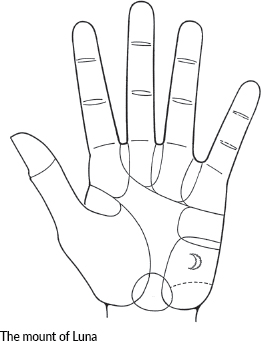
The ancients considered the Moon restless because it traveled quickly across the sky, disappeared altogether for a while and then appeared again during the course of each month. A large and prominent Luna signifies a restless person who enjoys travel and adventure. He may choose a career that takes him from place to place or he will travel for fun. Whether high or flat, a sizeable Luna shows a love for the countryside and the sea. A prominent Luna indicates, creativity and a powerful imagination. Obviously, if this area is flat and cramped, the subject does not enjoy travel and he may not have much imagination either.
A well-developed Luna indicates that the person is intuitive, sensitive to his surroundings, and possibly also psychic. He may be able to pick up images of the past and the future from people, objects or places. A high mount with a whorl or loop in the skin ridge pattern increase imagination and intuition to the point where the person might lose touch with reality from time to time.
Right at the bottom of the Luna mount is a bone just above where the hand joins the wrist. Modern palmists now call this area the mount of Pluto. I think they have just given it this name for convenience sake, because it has nothing to do with the Pluto with which astrologers are familiar.
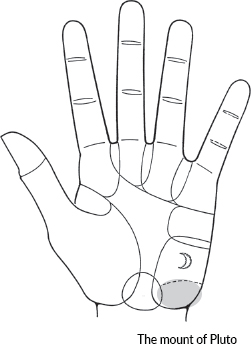
When the Pluto mount is high and wide, the person is very restless and he is a real traveler. He gets bored quickly unless he is on the move. If the mount is scarcely visible or it curves sharply inward at the percussion edge, he may enjoy the occasional week's holiday but he really prefers to be at home.
The easiest way to think about these mounts is to consider that Venus loves people and things that they can experience with their five senses. Luna and Pluto represent a love of travel and those things that are beyond the physical senses.
Now things get a little complicated. The whole of the central area of the hand is devoted to Mars, but it subdivides into upper Mars, lower Mars and the plain of Mars.
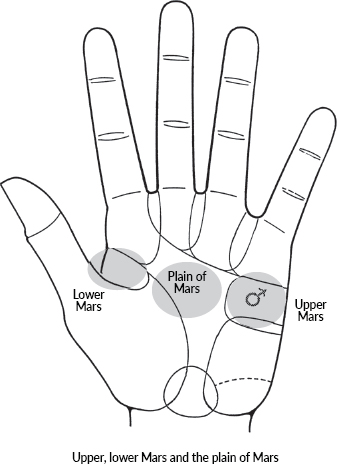
Upper Mars is located at the percussion edge of the hand and this relates to fighting ability and reactions such as anger and belligerence. It is hard to shock the individual when this area is high or if there is thickness through the hand. He may fight with words or with his fists but he will not put up with anything that he doesn't like. This person may choose to serve in the armed forces, the police, or the fire department or as an emergency medic. He enjoys being where the action is. However, if upper Mars area bows outward at the edge, he has creative talent and he may work with his mind and hands in a creative manner. He may also be unreliable or even crooked, because what he wants is important to him and he doesn't much care how he gets it.
If this area is thin, the subject is nervous. He may have been bullied when he was young and he never really developed much courage. If he tucks his thumb into his fingers, he is very nervous, frightened and unsure of himself. This gesture gives him a form of self-comfort and reassurance.
If the edge of the hand is straight rather than bowed, the subject is a good record keeper, proofreader, secretary or analyst. He can interpret and improve the ideas of others but he may not be creative in his own right.
Lower Mars is often actually higher on the hand than upper Mars. Lower Mars is located on the hand and palm around and below where the thumb opens away from the hand and it is inside the lifeline. Someone with a prominent, large or “full” lower Mars mount can be counted on to do his duty. As a youngster, he may have been a Scout, a cadet or something of the kind. He is a good team member, especially if there is serious work to be done and he would thoroughly enjoy a spell as a military leader.
A flat, indented or cramped area here belongs to an individual who sees no need to join pressure groups or to get into uniform. He's probably too unconventional and independent to be a good team member.
The plain of Mars is the flat area in the center of the hand. While each mount relates to a specific aspect of life (status, family, life, travel, and so forth), the plain of Mars does not. Many lines traverse this area, and a skilled palmist can spot health problems arising from the marks and colored patches that appear in this area.
Neptune represents a link between the conscious and unconscious mind and also between the spiritual and the material world. Psychics, spiritual mediums, artists, psychologists, dream analysts, creative people and those who travel a great deal have well developed Neptune mounts. This links the material world of Venus with the imaginative or psychic world of Luna. It also links the conscious and unconscious mind.
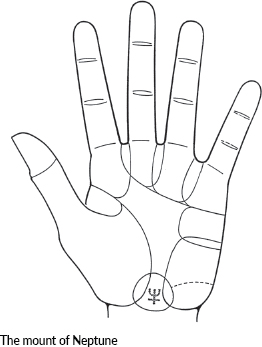
The joint where the thumb meets the hand is the angle of dexterity or the angle of rhythm. If it is reasonably well developed, the person has a certain gracefulness, he rarely drops anything and he is good with his hands. He also has a sense of timing. This is useful if he enjoys music—even hip-hop and rap—dancing and sports. This man has the kind of timing that makes him good at telling jokes. He has an instinctive feel for the right time to speak or to clam up and the right time to do anything.
The angle at the base of the hand on the thumb side is called the angle of harmony. If it is sharply angular and has a marked “corner,” the subject has a profound interest in music and may very well be a singer or musician.
